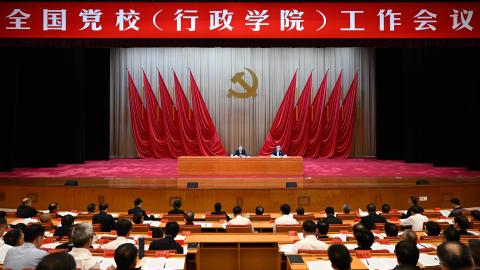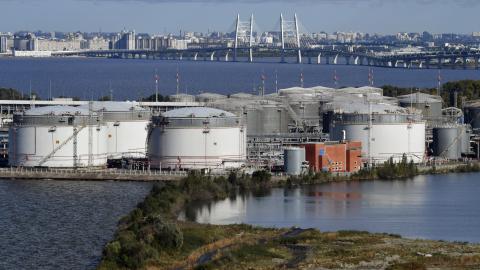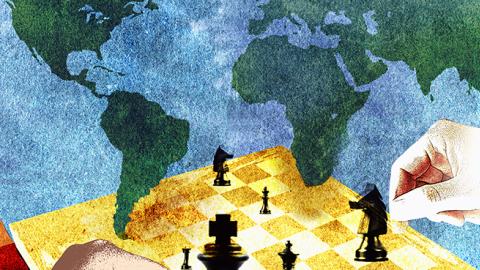With the Trump administration’s controversial decision to withdraw from the nuclear deal with Iran, the confrontation between the U.S. and the Islamic Republic has entered a new stage. Many of America’s European allies fear that Donald Trump is retracing the path of George W. Bush toward war in the Middle East—this time with a country that is larger, more complicated, better armed and more populous than Iraq. That is almost certainly an oversimplification. As Mr. Trump’s North Korea diplomacy has shown, he is capable, for better or worse, of combining sensational threats with extraordinary overtures of peace. He can shift from threatening North Korea with “fire and fury” one week to promising aid and trade the next. His Iran policy is likely to be at least as dramatic, confusing and hard to predict.
Now that the U.S. has withdrawn from the nuclear deal, the next question raging in and around the administration appears to be whether the American goal should be to change Iran’s behavior or to topple its regime. Before taking up his post as national security adviser, John Bolton was clear about where he stood. “The behavior and the objectives of the regime are not going to change and, therefore, the only solution is to change the regime itself,” he said in July 2017. In May 2018, Trump attorney Rudy Giuliani told reporters that the administration is “committed to regime change” in Iran.
In its own gradualist way, the Obama administration also aimed to bring about regime change in Iran. As Barack Obama said in a 2015 NPR interview, “I think there are hard-liners inside of Iran that think it is the right thing to do to oppose us, to seek to destroy Israel, to cause havoc in places like Syria or Yemen or Lebanon. And then I think there are others inside Iran who think that this is counterproductive. And it is possible that if we sign this nuclear deal, we strengthen the hand of those more moderate forces inside of Iran.”
A month later, Robert Gates, who served as President Obama’s secretary of defense in his first term, described the goals of this approach more concretely. As he said on “Face the Nation,” “[T]he pursuit of the (nuclear) agreement is based on the president’s hope that over a 10-year period with the sanctions being lifted that the Iranians will become a constructive stakeholder in the international community. That—as their economy begins to grow again, that—that they will abandon their ideology, their theology, their revolutionary principles, their meddling in various parts of the region.”
In Mr. Gates’s estimation, the Obama plan was “very unrealistic,” but many observers in Europe and the U.S. continue to support the approach. American hostility has kept the hard-liners in power, they argue. If we end the external threat, Iran would become a “normal” country, less inclined to incite conflict across the Middle East.
The Trump administration is united behind the idea that the Obama approach will not work. The question is whether they will settle for a diplomatic compromise of some kind with Tehran (assuming they can get one) or will press on until the Islamic Republic comes to an end, overthrown either by its own people, an invasion or some combination of the two. Officially, at least, the administration claims to be open to compromise.
In his much-discussed speech at the Heritage Foundation on May 21, Secretary of State Mike Pompeo put forward a list of 12 changes the U.S. would like to see in Iran’s behavior in order to reach a settlement. The conditions are tough—an end to both its nuclear and ballistic missile programs, no more support for terrorist groups like Hezbollah and Islamic Jihad, withdrawal from Syria and so on—and many in Europe and elsewhere regard them as tantamount to a call for regime change.
But in an administration led by a man who considers himself a master deal-maker, everything is negotiable. Not even Mr. Trump’s closest advisers really know what his true bottom line is when negotiating with Iran. The president himself may well not know in advance, and his negotiating position is likely to evolve over time.
President Trump is an opportunist; he will weigh his decisions on Iran against his alternatives at any given point. As he listens to advocates for and against regime change, he will be looking at the politics and the theater as much as at the substance. The Jacksonian voters who constitute much of the president’s base like to see the U.S. looking dominant on the world stage, but while they are deeply suspicious of Iran, they do not want more Iraq-style conflicts in the Middle East. Sun Tzu wrote that the greatest general is the one who defeats the enemy without actually having to fight them; that is the kind of victory that Donald Trump wants.
Regime change as a foreign policy tool has a long history in the U.S., and it is mostly associated with Wilsonian foreign policy ideas—the belief that American security can best be achieved by spreading democracy around the world. Woodrow Wilson’s Fourteen Points made the democratization of Germany one of America’s war aims in World War I.
After the fall of the Soviet Union, promoting democratic transitions in formerly communist countries became a major concern of American foreign policy. Following 9/11, both the Bush and Obama administrations looked to the promotion of democracy as a way to undermine support for terrorism in the Islamic world. Many in the Bush administration hoped that regime change in Iraq—the replacement of Saddam Hussein’s brutal dictatorship with a democratic government—would transform the Arab world, and that Iraq would become a role model for other Arab countries.
These ideas do not resonate with President Trump and his closest advisers. He won the Republican nomination by attacking the neoconservative legacy in Republican foreign policy, denouncing what he saw as the folly of America’s role in Iraq. For their part, neoconservatives have mostly returned the president’s disdain, and many of the most prominent voices in the Never-Trump Republican caucus belong to neoconservatives who see his populist nationalism as a betrayal of the American mission in the world.
Mr. Trump’s skepticism about the value of toppling nondemocratic regimes reflects a general disillusionment in American public opinion about the place of democracy promotion in our foreign policy. In the halcyon days of the early 1990s, when freedom seemed to be sweeping the world, promoting such transitions looked like a cheap and easy way to advance our economic and security goals. Central and Eastern Europe teemed with enthusiastic new democracies; Chinese students were demonstrating for democracy in the streets of Beijing; it even looked as if a democratic Russia would become a good friend. The U.S. had succeeded in transforming Germany and Japan into friendly democracies after World War II, so why not renew that effort?
That optimism about democracy shaped George W. Bush’s approach to Iraq and to the broader Middle East. If Russia and Central Europe could become democracies friendly to the West overnight, it could happen in the Middle East too.
Today, such developments seem far less likely, and the Trump administration is more realist and less idealist than other post-Cold War American presidencies. It sees regime change not as a silver bullet for building a global order based on peaceful democracies but as an ordinary lead bullet for stopping dangerous adversaries dead in their tracks.
Given these shifts, the Trump administration is likely to address the question of regime change in Iran as a practical rather than an ideological issue. Can the U.S. make an acceptable deal with the current Iranian government? And if the goal is a deal, does it make sense to take steps to destabilize that government as a way of softening up Tehran’s negotiators at the bargaining table?
The answers are anything but clear. Based on recent history, Iran will probably not accept America’s conditions for a grand bargain unless it is coerced to some degree. At the same time, while Iran may be vulnerable to U.S. pressure aimed at weakening the regime’s hold on power, that kind of pressure could paradoxically strengthen Iran’s determination and perhaps even its ability to resist such pressure.
In a series of blog posts last winter, Middle East expert Kenneth Pollack of the American Enterprise Institute argued that Iran, if threatened by a campaign of regime change, is likely to escalate both its nuclear drive and its support for terrorist action against the U.S. and its allies. Mr. Pollack suggests that instead of focusing on destabilizing Iran at home, the U.S. should push back against Iran in Syria, Yemen and Iraq—while making clear that more direct action aimed at regime change is an option if Iran reacts to these pressures by escalating the conflict.
Raising the price of Iran’s international adventurism at a time of domestic economic hardship would force the regime to make difficult choices. Hopefully, under those circumstances, the idea of buying peace at home by making peace abroad would appeal to the mullahs.
Some believe that the regime, for all its bluster and bile, is more vulnerable to outside pressure than it looks. Iran today has a lot in common with the Soviet Union—another imposing regime that turned out to be unexpectedly brittle. In 1989, only 51% of the people in the Soviet Union were ethnically Russian; ethnic Iranians account for just some 53% of Iran’s population today. In an age of rampant nationalism like our own, it is hard for such multiethnic states, where no single group predominates, to hold together.
In the Soviet case, Marxist ideology, the Communist Party and the KGB held the country together. In Iran, radical Shi’ism, clerical networks and security institutions like the Revolutionary Guard fill those functions. Such arrangements work fine until, sometimes very suddenly, they don’t. The Soviet Union lasted for 70 years before it collapsed; the Islamic Republic turns 40 next year and is already showing its age. Religious fanaticism is on the wane, and corrupt power networks among both the clergy and institutions like the Revolutionary Guard have discredited the regime in the eyes of the people.
Iran’s non-Persian ethnic groups, once relatively quiet, are increasingly discontented with the regime. The wave of protests across much of the country this year has been strongest in the predominantly non-Persian districts. Iran’s Arab minority, largely concentrated in the oil-rich area near southern Iraq, are particularly unhappy. In both Iran and Iraq, anti-Persian feeling among Shi’a Arabs is a powerful force.
From an American point of view, a Soviet-style meltdown of Iran into smaller, mutually hostile states and/or chaos would be less than desirable. Wars akin to those of the post-Soviet and post-Yugoslav eras would further destabilize a region that has enough troubles already, sending millions of desperate refugees into fragile countries and ultimately on to Europe. If Iran’s formidable arsenal fell into the hands of bandits and radicals, as happened after the fall of both Saddam Hussein in Iraq and Moammar Gadhafi in Libya, American and allied security would be seriously affected.
There are enough failed states and broken regimes in the Middle East as it is. Adding a country as large and important as Iran to that mix would not bring the Trump administration much joy.
Vali Nasr, a Middle East expert at Johns Hopkins University, observed last fall that the Trump administration has a posture toward Iran but not yet a policy. In Secretary of State Pompeo’s recent speech, the outline of a Trump policy began to emerge. Those who want to place regime change at the center of America’s Iran strategy were disappointed.
Mr. Pompeo called for a forceful effort to halt Iran’s regional aggression, but the strategy relies mostly on external pressure: denying Iran financial resources by reimposing and tightening sanctions while offering military and financial aid to groups fighting Iranian-backed forces around the Middle East. Mr. Pompeo pledged that the U.S. would support the human-rights concerns of the Iranian people and highlight the costs to the Iranian economy of the regime’s corruption and regional meddling, but these initiatives are very far from a coherent strategy for regime change.
For now at least, behavior modification, rather than regime change, appears to be the focus of Trump policy toward Iran. That could change. Mr. Pompeo did not rule out a military response to any Iranian effort to relaunch its nuclear program, and other military action by Iran—say, in the waters of the Persian Gulf—could provoke a kinetic American response that could rapidly take both countries into uncharted territory.
But the administration’s priorities are clear: President Trump, whose goal is to reduce American exposure and commitments in the Middle East, appears to be more interested for now in making a deal with Tehran than in toppling the Islamic Republic.












